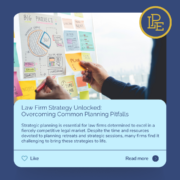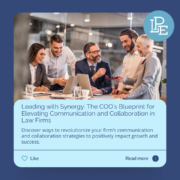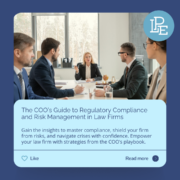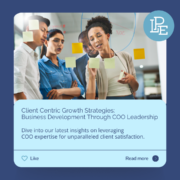
Building a Strong Employer Brand for Your Law Firm
In an increasingly competitive legal industry, attracting top talent requires more than just offering competitive salaries and benefits. Today, potential recruits are looking for firms that stand out not only for their legal prowess but also for their culture, values, and opportunities for growth. This is where the power of a strong employer brand becomes evident. An effective employer brand can differentiate your law firm, attract high-caliber candidates, and ultimately contribute to your firm’s success and reputation.
The Importance of Employer Branding
Employer branding is the process of promoting a company – in this case, a law firm – as the employer of choice to a desired target group, one that a company needs and wants to recruit and retain. The right employer brand communicates what makes your firm unique and why it’s a great place to work. It encompasses everything from your firm’s culture and values to career development opportunities and work-life balance initiatives.
A strong employer brand can help your law firm in several ways:
- Attracting Top Talent: Talented lawyers have their pick of places to work, so a strong employer brand that resonates with their values and career aspirations can make your firm stand out.
- Reducing Hiring Costs: A strong brand can reduce the need for extensive recruitment efforts by making potential candidates more likely to seek out your firm directly.
- Enhancing Retention: When employees feel aligned with their employer’s brand and values, they’re more likely to stay, reducing turnover and fostering a stable, experienced workforce.
Strategies for Building and Communicating Your Employer Brand
Define What Makes Your Firm Unique
Start by identifying the unique aspects of your firm’s culture, mission, and values. What makes your firm a great place to work? This might include your firm’s commitment to diversity and inclusion, innovative work practices, or community involvement.
Create a Value Proposition
Develop a clear employee value proposition (EVP) that outlines what employees can expect from working at your firm and what you expect from them. Your EVP should be compelling, setting you apart from other firms and resonating with the kind of talent you want to attract.
Showcase Your Brand Across Multiple Channels
Leverage your website, social media, job postings, and professional networks to communicate your employer brand. Share stories and testimonials from current employees about their experiences and achievements at your firm. Highlight your firm’s involvement in groundbreaking cases, community service, or work-life balance initiatives.
Engage Your Current Employees
Your current employees are your best brand ambassadors. Encourage them to share their work experiences on their personal and professional social media accounts. This not only amplifies your brand but also adds authenticity to your messaging. Encourage cross-promotion of social posts among your employees.
Continuously Monitor and Adapt Your Branding Efforts
Employer branding is not a set-it-and-forget-it task. Regularly seek feedback from employees and job candidates about how your firm is perceived as an employer and be prepared to adapt your strategies accordingly.
How We Can Help
We understand the unique challenges and opportunities within the legal industry and can offer tailored solutions that resonate with high-caliber legal talent. Here’s how we can assist:
- Brand Assessment: We’ll conduct an in-depth analysis of your current employer brand, including how it’s perceived internally and externally.
- Strategy Development: Based on this assessment, we’ll develop a comprehensive employer branding strategy that aligns with your firm’s goals and values.
- Implementation Support: We can assist with implementing your branding strategy across various channels, ensuring a consistent and compelling message is communicated.
- Training and Workshops: We offer training for your HR team and leadership on best practices for employer branding and employee engagement.
Building a strong employer brand is essential for attracting and retaining the top legal talent necessary for your law firm’s success. With our expertise, your firm can establish itself as a preferred employer, attracting professionals who are not only highly skilled but also a great fit for your culture and values. Let us help you create an employer brand that sets you apart and makes your firm the place top talent aspires to be.
In today’s competitive legal landscape, mentorship in law recruitment has become essential for law firms striving to attract top talent beyond offering a lucrative pay-check. As candidates increasingly prioritize professional growth and development opportunities, law firms must adapt their recruiting strategies to meet these expectations. One of the most effective ways to appeal to ambitious legal professionals is through robust mentorship programs. Mentorship not only plays a crucial role in attracting candidates but also significantly impacts talent development and retention.
Attracting Candidates with Mentorship Opportunities
For many legal professionals, the prospect of a mentorship program signals a firm’s commitment to its team’s career advancement and personal growth. A well-structured mentorship program can be a powerful tool in a law firm’s recruitment arsenal, setting the firm apart from competitors. It demonstrates a nurturing culture that values continuous learning and professional development, appealing to candidates who are not just looking for a job but a place to grow and thrive.
Mentorship programs provide a clear path for career progression, which is especially appealing to younger lawyers who are striving to make their mark in the legal field. These programs can help demystify the path to success within a firm, providing newcomers with the guidance and support they need to navigate their new environment and advance their careers.
Implementing Effective Mentorship Programs
Creating a mentorship program that truly adds value requires thoughtful planning and commitment. Here are key steps to developing a program that not only attracts talent but fosters long-term development and retention:
Define Clear Objectives
Start by identifying what you want the mentorship program to achieve. Whether it’s improving skill sets, increasing retention rates, or enhancing firm culture, having clear goals will guide the program’s structure and content.
Match Mentors and Mentees Carefully
Effective mentorship relies on strong, compatible matches between mentors and mentees. It’s essential to consider personalities, career goals, and areas of expertise when pairing individuals. To enhance these considerations, we have found DiSC to be a helpful additional tool. DiSC aids in understanding and aligning behavioral styles, which can significantly improve the matching process, leading to more meaningful relationships and impactful guidance.
Provide Training for Mentors
Mentoring is a skill that can be developed. Providing mentors with training on how to be effective guides can enhance the value they bring to their mentees. This training can cover communication techniques, goal-setting strategies, and ways to provide constructive feedback.
Set Expectations and Goals
Both mentors and mentees should have a clear understanding of the program’s expectations and their roles within it. Encourage them to set individual goals for what they wish to achieve through the mentorship, which can include skill development, networking opportunities, or career advancement objectives. If you have developed a well defined partnership track for your attorneys, this can help to easily guide individuals through goal setting for career progression (we can help with this).
Monitor Progress and Gather Feedback
Regular check-ins with both mentors and mentees help ensure the program is meeting its objectives. Solicit feedback to identify what’s working and areas for improvement. This iterative process is key to refining the program over time.
Foster a Culture of Mentorship
Mentorship should be a core part of the firm’s culture, not just a program. Encourage a firm-wide ethos of guidance and support, where everyone, regardless of rank, is open to sharing knowledge and experience. In an industry where time is short, mentoring can be a hard sell if it isn’t a core part of your firm’s culture. Consider ways to give credit for time spent mentoring (the billable hour is important, but so are many other things that contribute to your firm’s overall success).
How We Can Help
Understanding the pivotal role mentorship can play in recruiting and retaining talent, our leaders are equipped to help you develop and implement a mentorship program tailored to your law firm’s unique needs. We work closely with our clients to design mentorship programs that not only attract but also nurture and retain top legal talent, ensuring a thriving, dynamic work environment. Through resources like our Legal Management Exchange community, we provide additional support for these programs, offering training and development tools to enhance the effectiveness of your mentors and foster a supportive, engaging culture. Mentorship programs are more than just a recruitment tool; they are a cornerstone for fostering a development-focused culture within law firms. By investing in mentorship, firms can attract ambitious candidates, enhance their professional growth, and, ultimately, retain their most valuable asset—talented legal professionals.
Take the first step towards transforming your law firm’s future—connect with us today and discover how we can help you develop and implement a transformative mentorship program and drive your firm’s success.
The path to becoming a partner in a law firm has long been viewed as a pinnacle of achievement for lawyers. Traditionally, this path, or “partnership track,” was relatively straightforward, albeit demanding: excel in your work, bill a significant number of hours, and after a set number of years, you might be invited to join the ranks of partners. However, as the legal industry evolves, so too does the concept of the partnership track. This evolution is reshaping law firm recruitment strategies and offers a unique opportunity to attract ambitious lawyers seeking more than just a traditional career path.
How Traditional Partnership Tracks Are Changing
The legal profession is witnessing significant shifts in how partnership tracks are structured. Factors such as work-life balance, the desire for more flexible work arrangements, and the need for a more diverse and inclusive workplace are driving these changes. As a result, law firms are reevaluating and redesigning their partnership models to accommodate these evolving priorities.
Alternative Partnership Models
In response to these shifts, alternative partnership models are emerging. While research provides several scenarios, those we recommend are few:
- Non-Equity Partnerships: Offering a stepping stone to full equity partnership, non-equity partnerships allow lawyers to gain the title of partner and assume leadership roles without immediately taking on the financial risks and rewards of equity ownership. This can be a win-win for both the partner and the firm.
- Part-Time Partnerships: To accommodate lawyers seeking work-life balance, some firms offer part-time partnership tracks. This arrangement acknowledges that contribution to the firm’s success isn’t solely measured by billable hours. It allows an attorney to support the firm at the partner level but reduces the cost of the partner’s compensation.
- Merit-Based Tracks: Moving away from the traditional seniority-based promotion system, some firms now base partnership promotions on merit, considering factors such as business development success, leadership abilities, and specialization in niche areas of law. This can help to support lateral hires.
Utilizing Alternative Models as a Selling Point
These innovative partnership tracks can be powerful tools in recruiting ambitious lawyers. They appeal to a broader talent pool, including those seeking flexibility, work-life balance, or faster progression based on merit rather than years of service. By advertising these alternative tracks, law firms can attract candidates who are not only highly skilled but also aligned with the firm’s forward-thinking values and practices.
In addition, defining the firm’s partnership track supports retention. Today’s attorneys want to know what the road ahead looks like and how they achieve their goals for advancement. A firm who has provided a roadmap for advancement is showing their attorneys that their career progression is as important to the firm as it is to the employee.
How We Can Help
We understand the intricacies of law firm dynamics and the competitive landscape of legal recruitment. We can assist your firm in navigating the evolving partnership track landscape by:
- Analyzing your current partnership model to identify areas for adaptation or improvement.
- Designing alternative partnership tracks that align with your firm’s culture, goals, and the needs of modern legal professionals.
- Implementing recruitment strategies that highlight your innovative approach to partnership as a key differentiator in the market.
- Providing ongoing support and training to ensure your leadership and HR teams are equipped to manage and promote these new tracks effectively.
The evolution of partnership tracks represents a significant shift in the legal profession, reflecting broader changes in work culture and professional aspirations. By embracing and promoting alternative models, your law firm can position itself as a leader in attracting, developing, and retaining the next generation of legal talent.
Our team is here to guide you through this transformation, ensuring your firm remains competitive and appealing to ambitious lawyers looking for a place to thrive.















